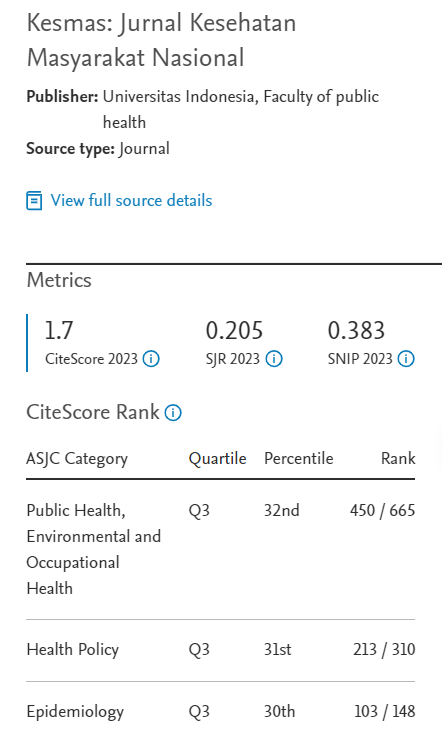Abstract
Sejak tahun 2000 pos pelayanan terpadu (posyandu) telah berkembang baik, tetapi kekurangan dana dan pelatihan mengalami penurunan kinerja akibat krisis ekonomi. Hal tersebut terlihat pada penurunan kunjungan dan drop out kader yang menghadapi banyak tugas, besar cakupan, dan kurang mampu merespon tuntutan masyarakat. Pedoman World Health Organization (WHO) terakhir menyatakan bahwa untuk menjamin keberlanjutan program jangka panjang, kader perlu dibayar. Kabupaten Penajam Paser Utara memberikan insentif kader terbesar di Indonesia. Studi inimengkaji peningkatan kinerja kader posyandu di Kabupaten Penajam Paser Utara pada tahun 2010 akibat pemberian insentif uang tunai. Penelitian kualitatif yang menggunakan rancangan fenomenologi ini menghimpun data 18 orang meliputi 15 orang dari instansi pemerintah dan 3 orang kader. Studi dengan metode analisis isi ini menemukan bahwa pemerintah memberikan uang sebagai insentif bagi kader menyebabkan kader bersemangat dalam bekerja dan berkompetisi. Pemerintah terlihat sangat berperan meningkatkan kinerja kader, tetapi masyarakat masih kurangberperan. Studi ini menyimpulkan bahwa insentif uang tunai dapat meningkatkan kinerja kader posyandu.
Since 2000 Posyandu has grown well, but its performance was declining as indicated by the decreasing of visitors as well as the cadres because economic crisis. The problems within the cadres include excess workload and area to be covered and lack of capability to respond to the community demand.The latest guidelines of World Health Organization (WHO) identified that cadres incentive is needed for the long term sustainability. Penajam Paser Utara which gave the highest incentive in Indonesia for its cadres. This study was aimed to explore in depth the Penajam Paser Utara cadres performance improvement in 2010 in relation to financial incentives. This isa qualitative study using phenomenologic design. Informants were 18 persons origined from the government office and 3 cadres. Data were obtained through indepth interview and analysis using content analysis. The result showed that the government provided financial incentive for cadres recognition and posyandu revitalization. Financial incentive was found motivated the cadres to work and enhance their competence. Although the government had played role in improving cadres performance, yet the community still had limited participation. It could be concluded that financial incentive could improve performance of posyandu cadres.
References
1. Kementerian Kesehatan Republik Indonesia. Pedoman manajemen peran serta masyarakat. Jakarta: Kementerian Kesehatan Republik Indonesia; 2006.
2. Syafei M, Lazuardi L, Hasan BM. Pemberdayaan kader dalam revalisasi posyandu. KMPK UGM. 2008; 14.
3. Gilson L, Walt G, Heggenhougen K, Owuor-Omondi L, Perera M, Ross D, et al. National community health worker programs: how can they be strengthened? Journal of Public Health Policy. 1989; 10(4): 518-32.
4. World Health Organization, Global Health Work Force Alliance. Scaling up, saving lives. Geneva: World Health Organization, Global Health Work Force Alliance; 2008.
5. World Health Organization, President’s Emergency Plan for AIDS Relief, United Nations Programme on HIV/AIDS. Task shifting: rational redistribution of task among health workforce teams. Global Recommendations and Guidelines. Geneva: World Health Organization; 2007.
6. Abbat F. Scaling up health and education workers: community health workers. London: DFID Health System Resources Centre; 2005.
7. Lewin SA, Dick J, Pond P, Zwarenstein M, Aja GN, Van Wyk BE. Lay health workers in primary and community health care. Cochrane Database of Systematic Reviews. 2005.
8. Baker B, Benton D, Friedman E, Russell A. Systems support for task shifting to community health workers. Geneva: The Global Health Alliance; 2007.
9. Chevalier C, Lapo A, O’Brien J, Wierzba TF. Why do willage health workers drop out? World Health Forum. 1993; 14: 258-61.
10. Bhattacharyya K, Winch P, Leban K, Tien M. Community health worker incentives and disincentives: how they affect motivation, retention, and austainability. Basic Support for Institutionalizing Child Survival Project (Basic II). Arlington: The United State Agency for International Development; 2001.
11. Haines A, Sanders D, Lehmann U, Rowe AK, Lawn JE, Jan S. Achieving child survival goals: potential contribution of community health workers. Lancet. 2007; 369 (9579): 2121-31.
12. Lehmann U, Sanders D. Community health workers: What do we know about them? the state of the evidence on programmes, activities, cost an impact on health outcomes of using community health workers. Geneva: World Health Organization; 2007.
13. Sulistyanto. Pengaruh pelatihan kader dengan media audio-visual terhadap pengetahuan, sikap serta perilaku kader posyandu di Kecamatan Sintang Provinsi Kalimantan Barat [tesis]. Yogyakarta; 2005.
14. Soekirman. Perlu paradigma baru untuk menanggulangi masalah gizi makro di Indonesia. 2001.
15. Glenton C, Scheel IB, Pradhan S, Lewin S, Hodgins S, Shrestha. The female community health volunteer programme in Nepal: decision makers’ perceptions of volunteerism, payment, and other incentives. Social Science and Medicine. 2010: 1920-27.
Recommended Citation
Wisnuwardani RW .
Insentif Uang Tunai dan Peningkatan Kinerja Kader Posyandu.
Kesmas.
2013;
7(1):
44-48
DOI: 10.21109/kesmas.v7i1.75
Available at:
https://scholarhub.ui.ac.id/kesmas/vol7/iss1/7







